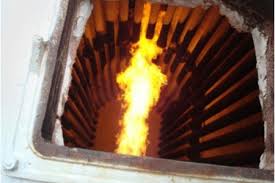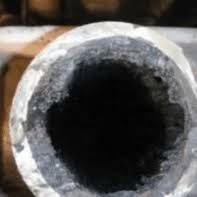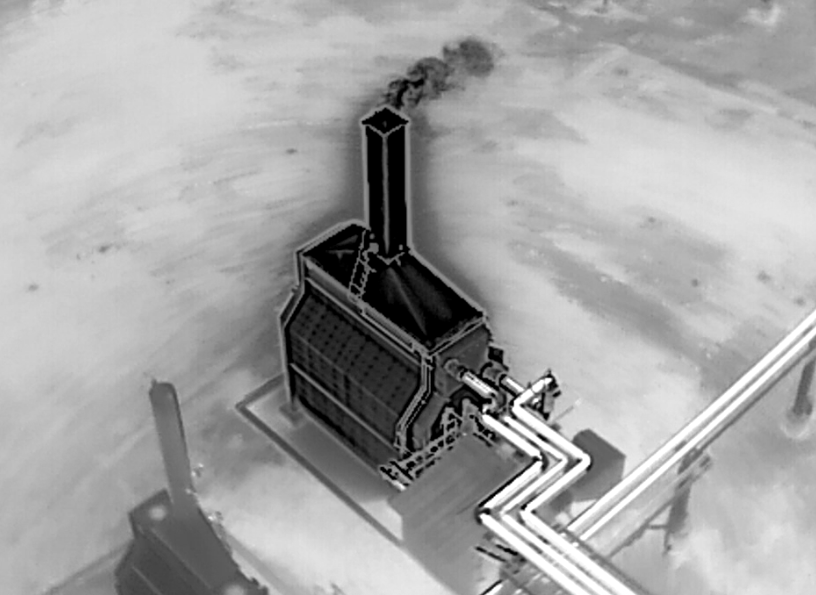
5 Common Fired Heater Malfunctions
Fired heaters are complicated, and it's a delicate balance to get them and keep them running well. While it's a challenge to run a heater well, it will typically be able to run poorly for many years, albeit with a loss of efficiency and an increase in damage and dangerous operating conditions. What follows are 5 common heater malfunctions and how to handle them.
1. Flame Impingement
Flame impingement occurs when the burner flame makes direct contact with the tubes. This is not allowable under API-560 (see section 14.1.1), and actually creates dangerous conditions, as the flame temperature is much hotter than the flue gas. It can cause rapid local creep, spalling, and heavy coking.
The heater was designed to balance heat from the flue gas, and may not be able to maintain safe tubeskin temperatures with direct flame impingement.
The best way to confirm this malfunction is to observe the flame using a viewport, or a thermal camera which can show hot spots on tubes. Other signs include temperatures on the tubeskin thermocouple trended data that are too high for the given metal, visible discoloration of the tubes, and deformations indicating pre-rupture conditions.
Fix this problem by stabilizing and shortening the flame. Achieving this might require realigning and cleaning the burner, and verifying correct heater draft, which should be negative throughout the heater and about -0.1" WC at the arch.

2. Fouling and Coking
Fouling (external deposits of soot, ash and oxidation products) and coking (internal carbon build-up) develop over time on heater coils, especially in "dirty" services. When local film temperatures exceed hydrocarbon stability limits, or when the film boils, carbon residues form and adhere to metal surfaces. This deposit acts like an insulating blanket, impeding heat transfer from the flue gas to the process fluid, lowering overall efficiency and forcing higher tube-metal temperatures to deliver the same duty.
Astute operators can easily detect fouling by observing the heater's efficiency slowly worsen over months, the tube metal temperatures slowly climb, and pressure drop increases across the coil (for internal coking)
Fouling can be prevented or delayed by keeping flux rates low. This means not firing the heater harder than it was designed, and keeping process flow rates acceptably high to ensure turbulent flow and mixing. Reversing the effects of fouling involves steaming, or pigging the coil. For outside fouling, maintenance personnel use a pressure wash or chemical wash to remove buildup.

3. High Stack Temperature
A stack temperature higher than necessary is literally waste heat. It not only indicates wasted fuel gas, but also could jeopardize the plant's emissions compliance. If secondary combustion is occurring in the convection section, the high stack temperature could be indicative of a damaging operating condition.
One cause of a high stack temperature is excessive fouling in the convection section -- this would limit the ability of the convection coil to cool the flue gas. Another potential problem is the draft itself. Excess fuel could lead to secondary combustion, a situation where combustion is continuing past the radiant section and in the convection section. Excessive air leakage into the convection section can also cause this problem.
Quick solutions are to keep stack O2 levels within the design envelope, clean the convection coil inside and out, and ensure a proper draft throughout the heater.

4. Insufficient Draft
Insufficient draft is a common problem in natural draft heaters that are being pushed well past their design duty. The symptoms of this issue are a lazy flame, inability to fire past a certain duty, low draft readings in the arch, secondary combustion, and "pops" which occur when fuel builds up and suddenly combusts. The last of these symptoms is extremely dangerous and can lead to explosions or heater burndowns.
There are numerous ways to improve the draft profile of a heater. In the case of dangerous conditions, the operator should turn the unit down until safe draft conditions are met (negative draft throughout, with -0.1" WC at the arch). What follows is a list of remedies:
- Turn the unit down immediately until you regain –0.1″ WC at the arch.
- Manually tune the air registers and damper
- De-coke the heater tubes. This leads to more efficient heat transfer, requiring less flue gas, and thus less gas-side pressure drop.
- Add a blower or fan to the gas-side system
- Increase the diameter or length of the stack
5. Interlock Failures
Interlock failures happen when a safety or operational interlock—flame scanner, temperature or pressure switch, flow monitor, valve feedback, etc.—either won't trip under unsafe conditions or nuisance-trips during normal operation. This matters because interlocks are your last line of defense against flameouts, overheat, low-air runaway and other scenarios that can damage tubes, refractory or even cause safety incidents.
You'll spot a problem when burners refuse to light, you get spurious lockouts or alarms (flame fail, high-temp, low-air, valve-fail), or worse, no shutdown when you deliberately open an emergency trip. These symptoms indicate that your safety systems aren't functioning as designed, creating dangerous operational conditions.
Troubleshooting starts with a review of your interlock logic diagrams and event logs, followed by bench-testing switches, transmitters, detectors and valve position feedback, plus a wiring and terminal-block check.
The cure is usually recalibrating or replacing the bad sensor or switch, fixing wiring or loose terminals, updating setpoints or logic in your DCS/ESD, and instituting routine proof tests so every interlock reliably does its job.
Do not simply jump the interlock.

Try it today and see how much time you can save!